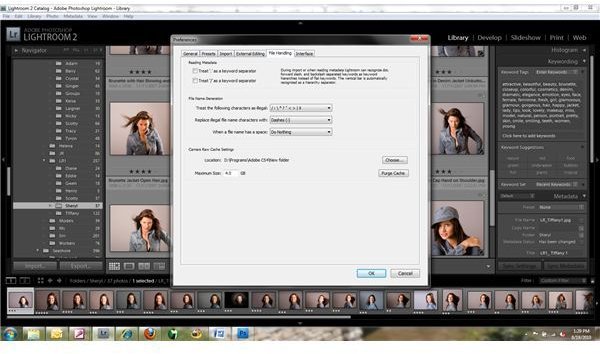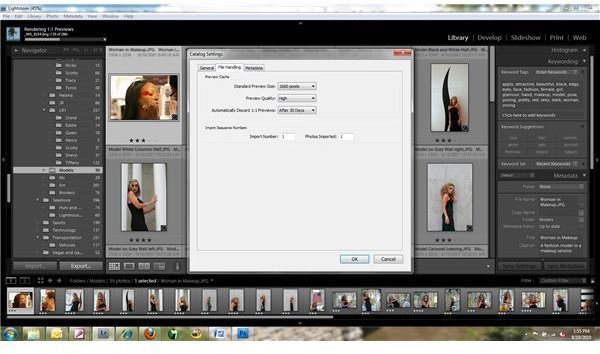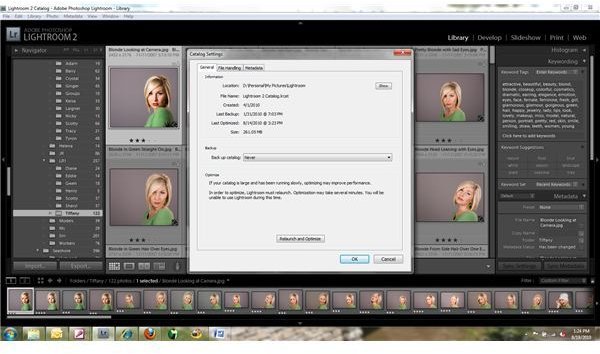Lightroom Speed Issues: Tips on How to Optimize Lightroom Speed
Lightroom Introduction
Adobe’s Lightroom is a great product for enhancing and mastering a photographer’s workflow when viewing, cataloging, processing and archiving digital photographs. It contains most of the tools a digital photographer will need to take images from the camera to the final product. The problem with a software package of this size and scope is that it can become bogged down with its own data and become slow and sluggish. There are several things one can do to improve the speed of Lightroom and return it to a state where working with it is a speedy pleasure.
Relaunch and Optimize
Optimize the Catalog
Like many programs of this type, Lightroom uses a catalog to keep track of images and store data about those images, including thumbnail copies. Over time, especially if the program is used frequently and/or images are moved around a lot, this catalog gets heavy and cumbersome. One of the easiest ways to improve Lightroom speed is to occasionally optimize the catalog. To do this, go to the “Edit” menu and click on “Catalog Settings.” At the bottom of this window click the “Relaunch and Optimize” button.
Cache Size and Location

Increase Cache
On a computer with plenty of disk space and/or an external device attached, increasing the size of the “Camera Raw Cache” can help. Lightroom uses this file to store previews of images when developing raw files. It defaults to 1GB, but the larger the better. Go to the “Preferences” menu under “Edit” and click on the “File Handling” tab. Change the location if necessary and increase the minimum size to whatever amount is freely available.
Change Preview Settings

Optimize Preview Sizes
Building preview images is an operation that greatly affects program speed. When importing images, make sure the box that says “Render Standard-Sized Previews” is checked. Once imported, open the “Library” menu, click on “Previews” and click on “Render 1:1 Previews.” Make sure all the images in the folder are selected.
Modify Preferences

Change Preferences to Match the Computer
Previews can also be optimized for the specific monitor it is used on. Under the “Edit” menu, click on “Catalog Settings” and highlight the “File Handling” tab. To optimize the previews, the “Standard Preview Size” can be set to the best resolution of the monitor. To optimize speed, however, this number should be lowered. In the same way, the “Preview Quality” setting can be tweaked to improve previews or improve speed. Finally, the “Automatically Discard 1:1 Previews” should be set to a date to eliminate the wasted space that is no longer needed.
Metadata
Many photographers add a great deal of metadata to their images for sale or archiving. Much of this is the same for every image, such as the photographer’s name and contact info. All of this information should be entered at the time of import, preferably from a preset. Even things such as keywords should be added at import for large numbers of files of the same subject or from the same shoot. This will not only save a lot of time later, but save the processing speed needed to add this information from the keyboard one image at a time. Metadata, especially copyright information is an important addition for the professional photographer. Optimizing this process is critical to incorporate into the workflow early on before a catalog reaches into the thousands of images.
Optimize the Computer
Finally, there are tips that can help any program run faster, not just when dealing with Lightroom speed issues. Installing as much memory as the hardware and operating system can handle is the best way to improve speed. Also, the more free space available on the hard drive, the faster programs that need to cache data will run. Running “Disk Cleanup” and “Defrag” weekly will go a long way to improving computer speed. Uninstall programs that aren’t needed can free up additional space and other resources. Shutting down the computer at least once a week, if not daily, will free up memory and resources as well.
